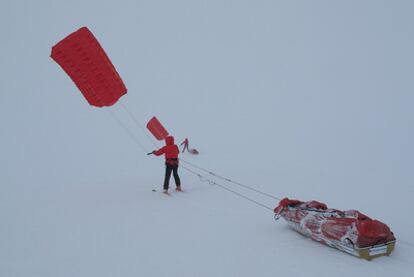Amundsen's way, but without dogs
Iñurrategi, Vallejo and Zabalza attempt 3,700km polar crossing with wind kites
For three people like Alberto Iñurrategi, Juan Vallejo and Mikel Zabalza, robust mountaineers and well-known climbers, traversing the flat terrain of Antarctica should be a minor accomplishment, free from the verticality they are used to facing. Or that at least is what anyone who did not witness their preparations for the expedition would assume. Days of uncertainty, hard work and more unknowns ahead of a journey that will take almost three months.
Their discretion, modesty and concern, which could fool you into thinking they are exaggerating, makes them reserved. But there is little doubt, novices in the art of polar crossings as they are, that the three went through hell traveling across Greenland south to north. "But that helped us enormously," says Vallejo. "Because we really learned how to handle the kites and corrected a lot of errors that in Antarctica we cannot repeat."
To complete the 3,700-kilometer journey ? which they embarked on on Tuesday ? from the northern Russian base of Novolazarevskaya as autonomously as possible, the three members of the BAT Basque team will have to move as swiftly as possible while carrying 170 kilos each. A journey no one has successfully completed before, it seems impossible.
A century ago, Roald Amundsen and his four-man team were the first explorers to reach the South Pole. His success was the ruin of Robert Falcon Scott, who reached the objective a month later with his four companions, all of whom perished on the return journey. Like Iñurrategi, Vallejo and Zabalza, Amundsen used sleds... pulled by 50 dogs. "The challenge, of course, is to do it without dogs but in the best scenario a man can only advance 25 kilometers a day pulling a heavy sled, so we have looked to modernity," Zabalza says. "We have kite sleds that will pull away from us like Amundsen's dogs a century ago." A spartan man familiar with suffering, Zabalza does not remember Greenland fondly. "There were moments when, pulling the sled, which weighed 100 kilos, 70 fewer than on this expedition, I had to ask Juan and Alberto for a stop. I thought I was going to faint from the exertion."
Neither when the wind is up does the pain subside: "We completed 250 kilometers in a day, but we almost lost our quadriceps in the effort," chuckles Vallejo. To control the sleds in fierce winds places huge demands on the legs, abdominal muscles and the lumbar vertebrae. Nevertheless, the sleds are upturned time and again, forcing the others to stop and help their companion, which is when the cords of the kites become entangled. And all this at 30ºC below zero. "We are hoping that in Antarctica, which is colder than the North Pole, the snow will be harder and the sleds will move better, so we won't get battered about as much," say Vallejo.
The team has also fashioned a special harness that will aid them when climbing and lessen the impact of the weight on the lumbar region. Eighty of the 170 kilos they will each carry is food; the rest climbing equipment, overnight gear, spare skis, communication material (GPS, laptops, satellite telephones, cameras and video cameras, solar panels, and so on), fuel, first aid kits and changes of clothes.
The packed food consists of 70 little bags, one for each day, in which there are three other bags containing breakfast, lunch and dinner. The team will consume 5,000 calories each a day. If the food runs out before they complete their journey, they will have a serious problem. If an accident occurs that prevents them from continuing, their salvation is also far from assured because the rescue aircraft cannot land just anywhere. "We will have to move to a place from where they can evacuate us... That's if we can, of course," says Vallejo.

Tu suscripción se está usando en otro dispositivo
¿Quieres añadir otro usuario a tu suscripción?
Si continúas leyendo en este dispositivo, no se podrá leer en el otro.
FlechaTu suscripción se está usando en otro dispositivo y solo puedes acceder a EL PAÍS desde un dispositivo a la vez.
Si quieres compartir tu cuenta, cambia tu suscripción a la modalidad Premium, así podrás añadir otro usuario. Cada uno accederá con su propia cuenta de email, lo que os permitirá personalizar vuestra experiencia en EL PAÍS.
¿Tienes una suscripción de empresa? Accede aquí para contratar más cuentas.
En el caso de no saber quién está usando tu cuenta, te recomendamos cambiar tu contraseña aquí.
Si decides continuar compartiendo tu cuenta, este mensaje se mostrará en tu dispositivo y en el de la otra persona que está usando tu cuenta de forma indefinida, afectando a tu experiencia de lectura. Puedes consultar aquí los términos y condiciones de la suscripción digital.
Últimas noticias
Reinhard Genzel, Nobel laureate in physics: ‘One-minute videos will never give you the truth’
Pinochet’s victims grapple with José Antonio Kast’s rise in Chile
From digital curfews to blocking apps: How technology experts protect their children online
Why the price of coffee has skyrocketed: from Brazilian plantations to specialty coffee houses
Most viewed
- Pablo Escobar’s hippos: A serious environmental problem, 40 years on
- Why we lost the habit of sleeping in two segments and how that changed our sense of time
- Trump’s obsession with putting his name on everything is unprecedented in the United States
- Charles Dubouloz, mountaineering star, retires at 36 with a farewell tour inspired by Walter Bonatti
- The Florida Keys tourist paradise is besieged by immigration agents: ‘We’ve never seen anything like this’








































